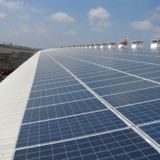Information
-
Project Name
-
Client
-
Conducted on
-
Prepared by
Project Details
-
Module Make & Model
-
Number of modules and Array DC sizing
-
Racking manufacturer
-
Racking type
-
Racking attachment method to building
-
Inverter manufacturer & model(s)
-
Monitoring Equipment Details
Building Structural
-
Structural reinforcements have been completed per Engineered Drawings
-
Purlin/top chord tie clips are present per layout and installation requirements
-
Final review has been completed by Engineer of Record
-
Final Building Permit sign-off has been completed by local Municipality
Racking Installation
-
Roof fasteners installed per Engineering requirements or recommended practices
-
Roof penetrations are secure and weather tight
-
L feet brackets fastened securely and correctly to roof mount hardware and rails
-
Rails and splices secured and fastened correctly, either single layer or double grid
-
Expansion joint rail bonding method present and installed correctly
-
Bonding method for entire racking system, present and installed correctly
-
Racking PV Module end clamps preinstalled where applicable
-
Combiner box mounting rails installed where required
PV Wiring
-
PV wiring preinstalled on racking and secured with clips and/or tie wraps
-
PV wiring secured with spiral wire wrap
-
PV wire end connectors installed and secure
-
PV wiring identified per string layout requirements
-
PV wiring neat and secured adequately to racking and modules
PV Module
-
PV Module model number matches construction plans
-
Number of PV Modules matches construction plans
-
PV Modules free form cracks and damage
-
Mid and end clamps present and secured correctly
-
Frame clamp positions meet module installation requirements
-
WEEB bonding clips present and installed correctly
-
PV modules connected in series per string layout
-
Maintenance walkways installed
DC Electrical Services
-
Combiner boxes installed correctly
-
PV wiring routed and installed to combiner boxes per construction plans and common practices
-
PV wiring secured adequately to terminals in combiner boxes
-
String voltage and polarity confirmed at combiner box terminals
-
String fusing installed and meets rated sizing for module strings
-
Home run conductors adequately secured to combiner box terminals
-
Racking grounding installed and secured in combiner box(s)
-
DC home run conductors installed, routed and secured per construction plans
-
Roof penetrations secure and weather tight
-
Underground trenching completed and returned to original condition where possible
Inverter(s) Installation
-
Correct inverter(s) installed and mounted securely
-
DC conductors routed tidily and secured to DC disconnect(s) or recombiner(s) where present
-
DC conductors connected correctly to inverter(s)
-
DC input voltage and polarity confirmed
Monitoring
-
Monitoring installed per approved monitoring plan
-
Is monitoring active
System Labeling
-
Equipment labels present per ESA requirements
-
Outdoor labels are rated to withstand elements
Commissioning
-
ESA final inspection certificate received for PV module installation
-
ESA connection authorization received for AC & DC electrical services
-
ESA final inspection certificate received for AC & DC electrical services
-
COVER and performance testing completed by LDC & Electrical Engineer
-
PV Analyser system check performed on array and documented
-
Operation of all AC & DC switches confirmed
-
Inverter(s) started up and operation confirmed
AC Electrical Services
-
Switchgear and cabinets present and installed correctly per construction plans and best practices
-
Has additional AC equipment been installed beyond construction plans (please detail)
-
New transformer installed along with required periphals
-
Underground trenching completed and returned to original condition where possible












